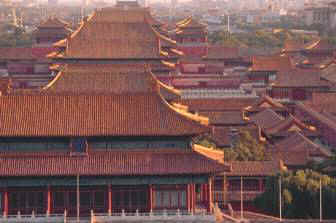
The
Beijing Palace Museum is the largest and best preserved ancient
architectural complex in China.
|
Museums
China had imperial and private
collections of cultural relics in each dynasty, but the first museum
worthy of the name in China was set up by foreigners in the mid-19th
century. The first museum established by the Chinese themselves
was the Nantong Museum, which was set up by industrialist Zhang
Jian in 1905. In 1912, preparations were made for the construction
of the History Museum, the first national museum after the founding
of the Republic of China, in the former Imperial College (the highest
educational administration in the previous feudal China) in Beijing.
In 1949, there were no more than 21 museums in China.
|
| In October 1949, the
Ministry of Culture established the State Administration of Cultural
Relics, which was in charge of the work of museums nationwide, and
drew up a series of decrees, guiding principles and policies concerning
both cultural relics and the setting up of museums. By 1999, there
were 1,371 museums nationwide run by cultural relics administrative
departments alone. If those run by other departments are included,
the total number of China’s museums will be well over 1,800. There
are museums specializing in social history, arts, minerals, local
customs, and science and technology. A large number of museums well
known at home and abroad, such as the Palace Museum, the Museum of
Chinese History, the China Aviation Museum, the China Geological Museum,
the China Coin Museum, the China Printing Museum, the Shanghai Museum,
the Nanjing Museum, the Shaanxi History Museum, the Henan Museum,
the Liaoning Provincial Museum, the Gansu Provincial Museum, and the
Yunnan Museum of National Minorities, as well as more than 300 memorial
museums reflecting the glorious revolutionary traditions of the Chinese
people, including the Museum of the Chinese Revolution, the Military
Museum of the Chinese People’s Revolution, the China Opium War Museum,
the Wuchang Memorial Hall for the Revolution of 1911, the Memorial
Hall of the Site of the Huangpu Military Academy, the Memorial Hall
of the Site of the First National Congress of the Communist Party
of China, the Jinggang Mountains Revolutionary Museum, the Yan’an
Revolutionary Memorial Museum, the Memorial Hall of the War of Resistance
Against Japan, the Former Residence of Sun Yat-sen, the Birthplace
of Mao Zedong and the Former Residence of Deng Xiaoping are noted
for their rich collections of cultural relics, exhibitions, social
educational roles, active academic atmosphere, substantial research
achievements and increasingly advanced modern scientific administration.
Attention is now being paid to the design and construction of new
museums to promote the coordinated development of quantity, quality,
type and distribution of museums. |



